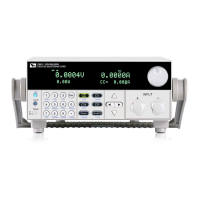Trace Subsystem
Copyright © ITECH Electronic Co., Ltd. 39
Chapter8 Trace Subsystem
The commands in this subsystem are used to configure and control data
storage into the buffer.
TRACe:CLEar
This action command is used to clear the buffer of readings. If you do not clear
the buffer, a subsequent store will overwrite the old readings. If the subsequent
store is aborted before the buffer becomes full, you could end up with some
“old” readings still in the buffer.
Command Syntax TRACe:CLEar
Parameters None
Example STAT:PRES
TRACe:FREE?
This command is used to read the status of storage memory. After sending this
command and addressing the electronic to talk, two values separated by
commas are sent to the computer. The first value indicates how many bytes of
memory are available, and the second value indicates how many bytes are
reserved to store readings.
Query Syntax TRACe:FREE?
Returned Parameters <NR1>, <NR1>
Examples TRAC:FREE?
TRACe:POINts
This command is used to specify the size of the buffer.
Command Syntax TRACer:POINts <NRf+>
Parameters 2 to 1000| MINimum | MAXimum | DEFault
*RST Value 1000
Examples TRAC:POIN 10
Query Syntax TRACe:POINts? [ MINimum | MAXimum | DEFault ]
Returned Parameters <NR1>
Related Commands TRAC:FEED
TRACe:FEED
This command is used to select the source of readings to be placed in the
buffer. With VOLTage selected, voltage readings are placed in the buffer,
TRAC:POIN maximum values is 2000. With CURRent selected, current
readings are placed in the buffer, TRAC:POIN maximum values is 2000 . With
TWO selected, voltage and current are placed in the buffer when storage is
performed, TRAC:POIN maximum values is 1000.
Command Syntax TRACe:FEED <CRD>
Parameters VOLTage | CURRent | TWO
*RST Value TWO
Examples TRAC:FEED VOLT
Query Syntax TRACe:FEED?

